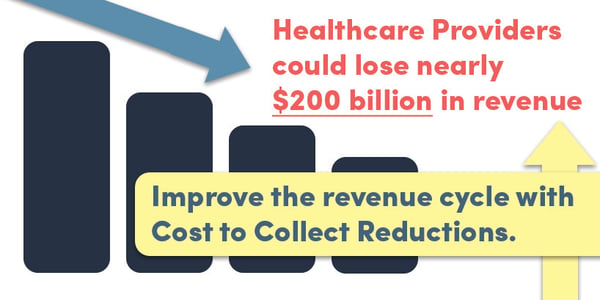 Healthcare providers could lose nearly $200 billion in revenue during the next year due to patient collections being written off. While payments from CMS and private insurance companies are often received within 30 days of a claim submission, patients can take much longer to settle their bills. According to research from TransUnion Healthcare, two out of three hospital patients don't even pay their bills in full. As direct patient responsibility to provide revenue grows, successful collections will become more important to the revenue cycle. This cost to collect will put a lot of additional pressure on healthcare organizations.
Healthcare providers could lose nearly $200 billion in revenue during the next year due to patient collections being written off. While payments from CMS and private insurance companies are often received within 30 days of a claim submission, patients can take much longer to settle their bills. According to research from TransUnion Healthcare, two out of three hospital patients don't even pay their bills in full. As direct patient responsibility to provide revenue grows, successful collections will become more important to the revenue cycle. This cost to collect will put a lot of additional pressure on healthcare organizations.
What Is Cost to Collect?
Cost to collect, according to the Healthcare Financial Management Association, is used to describe the overall costs of a healthcare patient collection efforts. In addition to communicating directly with patients, the calculation includes several different activities related to getting a bill paid, including insurance verification, clinical document improvement, and transcription and coding. It excludes physical location costs and expenses like software licensing fees.
Calculating an exact cost to collect figure can be very difficult for healthcare providers. This is partly because hospitals and other organizations often split collection responsibilities between many different departments, and roles can change year after year. Some providers have higher costs due to manual procedures like claim updating and medical records retrieval. Often departments will repeat the same tasks over and over again, wasting significant resources.
The costs of collecting individual charges change over time. As an unpaid bill ages, it requires more resources to collect and is less likely to be paid in full. Having a speedy and efficient billing system is crucial in preventing these escalating costs from getting out of control.
Improving the Revenue Cycle with Cost to Collect Reductions
Hospitals and other healthcare organizations are using a variety of strategies to reduce patient collection expenses. One strategy uses information gathered from patient records to determine the most cost effective collection tactics. Now that records are being shared across a wide range of organizations through EHR systems, analysis can be done on a very large patient pool. When collecting from low-income patients, many providers offer assistance with obtaining government benefits like Medicaid. While these strategies can be useful, reducing collection costs internally can come with a lot of limitations.
One of the more popular ways to reduce the cost to collect is to outsource. This has a few distinct advantages over internal collection efforts. One, companies that specialize in this area have discovered optimal ways to communicate with patients. Their staff have extensive experience and knowledge in the industry, making them more productive and efficient. In addition, outsourcing reduces the burden on healthcare staff so that they can focus on what they do best. All of these advantages can result in higher revenue and a significant return on investment.





